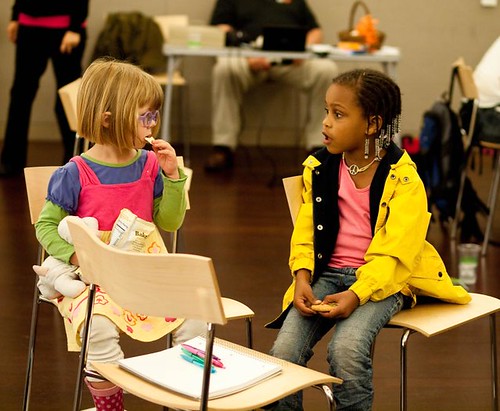Presenter Tips For Audience Discussions
“Nobody can’t teach nobody nothing,” says O. P. Kolstoe, author of College Professoring.
We need better presenters, as our conference attendees often suggest. Or we need better attendees as our speakers often state.
I think Kolstoe hit the bull’s-eye. As a presenter, so also a learner–the conference attendee. (paraphrased Joseph Lowman, 1995). If there is not instruction and learning happening on both sides of the presenter-learner situation, then what we call education is insignificant at best.
Defining A Discussion
Most importantly, a discussion is two-way spoken communication between conference participants. It also includes two-way communication between participants and the speaker. (Cashin & McKnight, 1986).
The best discussions occur on the smallest group level possible between pairs or triads. The bigger the group, the less each participant gets to share their own thoughts and insights.
Useful conference discussions consist of participants’ comments with other peers separated by frequent probes and clarifications by the presenter that facilitate involvement and development of thinking by the entire group. (Lowman, 1995) Peer discussions are not question and answer time normally at the end of the session.
Why Presenters Should Use Discussions
It is better for conference participants to be active seekers than passive recipients. Participants that are seeking to actively understand learn better than those that try to learn only through the lecture. Session discussions are one of the most common methods to promote active learning says researchers Bonwell and Eison, 1991.
Discussions are extremely effective in developing learners’ thinking skills and higher-level learning such as application, analysis, synthesis, and evaluation (Bloom et al., 1956), and also creativity (Anderson and Krathwohl, 2001; Bligh, 2000).
Why Lectures Prevail
So why is the lecture still the most prevalent model used in conference education especially when so many participants struggle to stay awake during the speaker’s monologue?
It is because the conference host, organizer and presenter all believe that the speaker’s understanding of the topic is transmitted directly to the brain of each audience member when both brains are tuned to the same wavelength. Ultimately they believe in learning by osmosis and the pouring of information into an attendee’s brain. Unfortunately, these assumptions are based on myth and not scientific fact about how our brains retain information, understand and learn. These assumptions are incorrect.
Tips for Presenters Using Discussions
Here are several tips to help presenters implement successful discussion during their presentations that lead to active learning.
1. Create an expectation for audience members to participate in discussion.
Use room sets that encourage discussion. Arrange seating so that people are sitting in pairs, triads or small groups. Share your expectations for discussion and set some ground rules. Always allow attendees to use the pass card if they don’t want to participate in discussions.
2. Create a safe space for all to discuss and disagree.
Help participants get to know others in their group through informal opening questions. Use startup questions like if I could do any other job than the one I’m currently doing, I would be_________________________. My favorite foods are ___________________________. My most favorite vacation was __________________________.
3. As a presenter, be prepared.
An effective discussion requires more preparation than an effect lecture. In a lecture, you decide what information to cover. In a discussion, presenters should be prepared to cover any issue that may be related to the topic.
4. After an initial opening question, start the discussion.
Start with a provocative question, a controversy or common experience. Choosing something from their professional lives is a great tactic for initiating conversation.
5. Follow the stages of good discussions.
a. Define the question, topic or problem to give the discussion focus.
b. Ask participants to suggest possible answers or solutions.
c. Collect relevant information that might help in solution finding.
d. Evaluate positions or solutions.
e. Ask the group to come to consensus about the best solution to try or best position to start.
6. Facilitate the discussion and the silence.
Be patient. Allow for silence and pauses as discussions may take time to ignite. Although the silence may feel awkward, it gives participants and speakers time to think. Teach yourself and your audience to get comfortable with silence. Walk around and listen to what is said and not said. Observe the audience and who is and isn’t participating.
6. Ask open-ended divergent, where more than one answer is possible, questions.
Yes and no questions don’t encourage discussions. Watch those close-ended, one-solution only, questions.
7. Constructively deal with conflicts.
Clarify what seems to be in disagreement. List pros and cons. Let the group talk about the disagreement.
8. Provide summaries.
Intermittently during audience discussions and at the end, debrief with summaries and perhaps a few conclusions.
9. Reflect on what happened during the discussion.
Hat tips (HT) to Kansas State University Professor, William Cashin; researcher and educator Joseph Lowman; and West Point’s master teacher Nathanial Watson.
How much time do you think presenters should allocate to audience peer discussions? When should conference education discussions occur?



Jeff,
Great points. I have tried presenter-facilitated discussions a few times and find that the number one success factor is simply your first point, create the expectation of discussion. Sadly, once I opened a presentation with “this will be more of a discussion than a presentation, with a lot of peer-based learning” and half the room walked out. The next time I tried it, I placed that expectation right in the title and called it an “experience.” Many participants do just want to listen to “experts,” and we know that there is value in good presentations, but just as much in facilitated learning experiences.
Bravo for pushing this idea forward, hope more conferences also embrace it when asking for submissions.